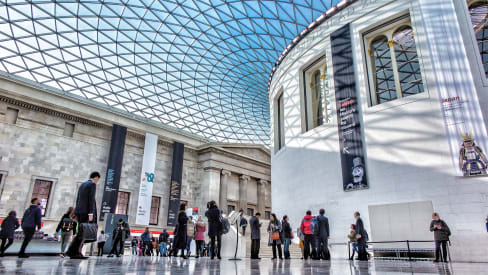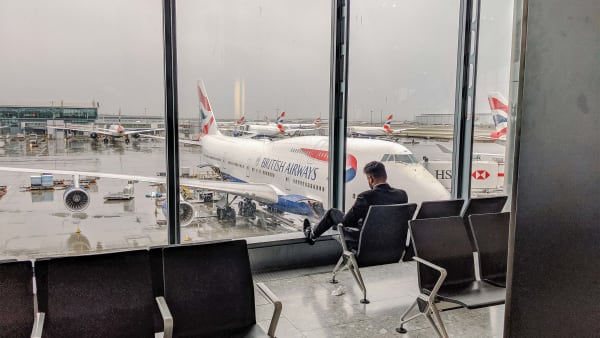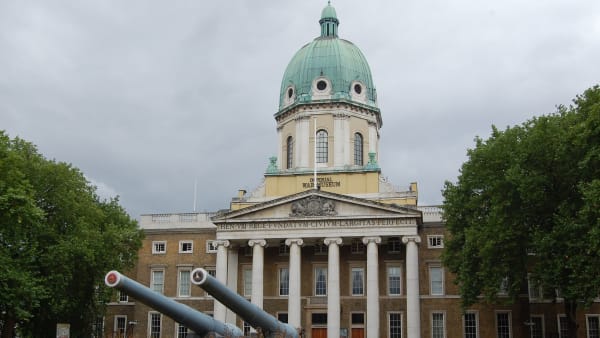British Museum
One of the most important and largest museums in the world, the British Museum, is an unmissable visit when in London. Expect thousands of precious cultural artefacts and archaeological finds spanning two million years of human history
British Museum
One of the most important and largest museums in the world, the British Museum, is an unmissable visit when in London. Expect thousands of precious cultural artefacts and archaeological finds spanning two million years of human history
The British Museum is a public museum in London’s Bloomsbury area dedicated to human history. As such, its holdings are mainly cultural art objects and antiquities. These objects make up a permanent collection of roughly 8 million items, one of the largest in existence.

The British Museum was founded in 1753 to house an impressive private collection of about 71,000 cultural artefacts and natural history specimens. That collection had been owned, up to his death, by Sir Hans Sloane, a naturalist and physician who had acquired the pieces in Sudan, Egypt, Greece, Italy, and various countries in the Americas, Middle East, and East and Southeast Asia.
Up until the mid-19th century, the museum was housed in a French-style mansion known as Montagu House and included a rich natural history collection. However, due to the museum’s steady stream of new additions, fueled by the numerous British colonial campaigns, the space soon became too small.
The natural history collections were thus moved to a museum of their own - the Natural History Museum. The antiquities and ethnography collections remained in the British Museum, which was by then housed in the new and expanded Greek Revival building designed by Sir Robert Smirke.
Many are the displays this institution is known for. However, among the holdings that make the British Museum so famous is certainly its huge Egyptian antiquities collection. After the Egyptian Museum in Cairo, this is the most comprehensive collection of such objects, and it includes pieces such as the Rosetta Stone and the 7.5 tonnes bust of Ramesses the Great. Other famous artefacts in the British Museum are the Parthenon sculptures, the brass Ife Head, the Aztec serpent, and the Hoa Hakananai’a (one of the Easter Island statues).
Another reason why the British Museum is so famous is the great controversy surrounding its possession of cultural art objects from other countries. The majority of these objects were taken by force through colonial expeditions and theft during the 18th, 19th, and 20th centuries. Among some of the most disputed objects in the British Museum are the Elgin Marbles (from Greece), the Benin Bronzes (from the Kingdom of Benin, Nigeria), the Ethiopian Tabots, the Rosetta Stone (from Egypt), and the artefacts from the Old Summer Palace (from China).
Many organisations and countries have petitioned for and demanded the restitution of numerous items, but very few have been returned to their native countries and peoples. Interestingly, the reason given by the British Museum for refusing the restitution of these items is that if it were to actually return everything that has been taken from other countries and peoples through colonial conquest and looting, the museum would have close to no collections left to exhibit.
What’s inside the British Museum
The British Museum is divided into eight departments. They are mainly divided by geographical origins, but there are a couple of departments identified by their items’ typology.
- Egypt and Sudan department: artefacts representing the cultures of the Nile Valley (10,000 BC - 12th century AD).
- Greece and Rome department: a collection of 100,000 objects from the Classical world - 3200 BC - 313 AD).
- Middle East department: a collection of Mesopotamian, Assyrian, Babylonian, and Sumerian antiquities consisting of about 330,000 works.
- Asia department: works from East Asia, South Asia, and Southeast Asia (Neolithic - present day).
- Africa, Oceania, and the Americas department: over 350,000 artefacts representing hundreds of indigenous cultures.
- Britain, Europe, and Prehistory department: objects dating back to the Paleolithic, Mesolithic, and Neolithic periods from all over the world, European items from the Bronze and Iron Ages, as well as European art and archaeology from the earliest times to the present day.
- Coins and Medals department: One of the largest numismatic collections in the world, with around 1 million objects among coins, medals, tokens, and paper money.
- Prints and drawings department: around 2 million Western prints and 50,000 drawings.
Location
Great Russell Street, London WC1B 3DG.
The British Museum is located in the Bloomsbury area, famous for its academic institutions and Georgian townhouses. In fact, the area has a high concentration of museums: not far from the British you can find the Petrie Museum of Egyptian Archeology, the Charles Dickens Museum, the Sir John Soane’s Museum, the Foundling Museum, and the Cartoon Museum.
But it’s not all just stuffy libraries and formal museums. Not far from Bloomsbury are some of the liveliest areas in London, such as Soho and Covent Garden.
Tickets and price
The British Museum in London is free to enter. Only some of the temporary collections require an entry fee. That said, the museum advises its visitors to book their visit ahead of time, as the number of entries per day is limited for safety reasons. You can book your free tickets for the British Museum on the official page . Remember you can book up to 9 entries at a time.
Visitors with a Membership do not need to book their ticket for the permanent collections, and often they don’t need to for the temporary collections either. If you’re interested in becoming a member you can check out the British Museum’s Membership page .
Schedule
The British Museum is open every day from 10:00 am to 5:00 pm, except on Fridays, when it stays open for a few extra hours, until 8:30 pm. The last entries are allowed until one hour before closure. The museum is closed only from the 24th to the 26th of December.
| Day |
|---|
| Mon-Sun |
| Fri |
| Day | Opening time | Last admission | Closure |
|---|---|---|---|
| Mon-Sun | 10:00 am | 4:00 pm | 5:00 pm |
| Fri | 10:00 am | 7:30 pm | 8:30 pm |
Transport
If you are taking the Underground, the closest stop is Tottenham Court Road, where three lines stop (Elizabeth, Central, and Northern). On the Northern, you can also find the stop Goodge Street. If instead, the Piccadilly line is easier for you, you can get off at and get off at Russel Square, and you’ll find the British Museum just on the other side of the green space
As for buses, line 14 gets lets you off right in front of the museum. If you can’t get this line, routes 19, 24, 29, 38, 55, 73, 98, 188, and 390 are also good options.
You can find a summary of the public transport options in the table below.
| Method |
|---|
| Lines |
| Stops |
| Method | Underground | Bus |
|---|---|---|
| Lines | Elizabeth, Central, Northern, Piccadilly | 14, 19, 24, 29, 38, 55, 73, 98, 188, 390 |
| Stops | Tottenham Court Road, Goodge Street, Russel Square | - |
It’s also possible to get a cab to the British Museum, but we don’t recommend it, considering traffic in central London is generally slow.
Nearby sights
Covent Garden - 750 m (0.5 miles) south, 9-minute walk.
Sir John Soane’s Museum - 800 m (0.5 miles) east, 11-minute walk.
Chinatown - 900 m (0.6 miles) southwest, 12-minute walk.
London Transport Museum - 1 km (0.6 miles) south, 12-minute walk.
Charles Dickens Museum - 1.1 km (0.7 miles) east, 13-minute walk.
National Portrait Gallery - 1.2 km (0.7 miles) south, 15-minute walk.
Piccadilly Circus - 1.3 km (0.8 miles) southwest, 16-minute walk.














